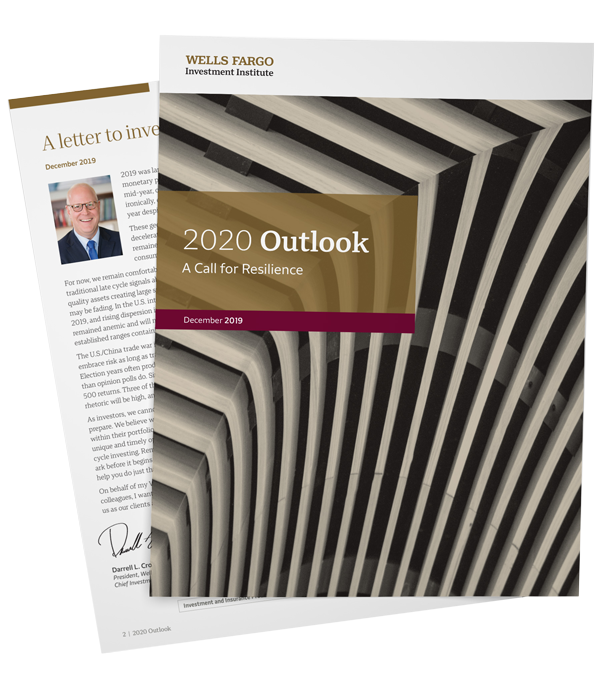Portfolio implementation
Investor guidance for 2020
Click the numbers below to learn more.
Investment and Insurance Products: NOT FDIC InsuredNO Bank GuaranteeMAY Lose Value
Entering 2020, the longest-ever bull market continues while market volatility and global uncertainties persist.
Portfolio implementation
Click the numbers below to learn more.
Cash alternatives have a place in an investment portfolio for:

For quality, we focus on U.S.-based large-cap companies with sizable cash positions, strong balance sheets, and growing dividends or share buybacks.
At the same time, we suggest de-emphasizing investments in lower-quality, small-cap companies.
Historically, we have seen outperformance in high-quality sectors such as Information Technology and Consumer Discretionary prior to recessions. Within fixed income, we see quality in highly rated U.S. corporate bonds.

We see several opportunities to pick up yield beyond low U.S. Treasury rates.
Within fixed income, we favor high-quality U.S. corporate bonds, residential mortgage-backed securities, and preferred securities.
Outside of fixed income, investors can find relatively attractive yields among international equities, which on average have higher dividend yields than U.S. equities, as well as in more defensive sectors such as Consumer Staples, Real Estate, and Utilities.
We continue to favor master limited partnerships (MLPs), where we see reasonable valuations and solid fundamentals.

Hedge fund strategies that have the potential to profit in both up and down markets may provide a good alternative late in the economic expansion.
Over the next few years, we favor Equity Hedge strategies.
We are currently neutral on the defensive Consumer Staples, Real Estate, and Utilities sectors, and unfavorable on the Materials and Communications Services sectors, which we expect to underperform in a late-cycle economy.

As painful as market downturns can be, they are a normal part of investing; historically, large-cap equities have experienced pullbacks of 5% or greater three to four times per year and corrections of 10% or more every year or so.
Investors may reduce short-term volatility risk by using cash tactically, focusing on high-quality assets, and positioning into more defensive asset classes and sectors. We believe one of the best long-run approaches is to diversify across a combination of low-correlated assets and regularly rebalance back to strategic targets.
The range of returns from year to year is from -22.1% to 29.0%, but on a rolling 10-year basis the range narrowed to 5.7% to 14.0%. This highlights the importance of a long-term perspective.
This page includes a chart graphic; a text alternative is available at the link below.A comparison of 1-year returns of a diversified portfolio from 1990 to 2018 and rolling 10-year returns starting in 2000.
The range of returns from year-to-year is from -22.1% to 29.0%, but on a rolling 10-year basis the range narrows from 5.7% to 14.0%.
Four-asset-group moderate growth and income portfolio: 3% Bloomberg Barclays U.S. Treasury Bills (1–3 Month) Index, 16% Bloomberg Barclays U.S. Aggregate 5–7 Year Bond Index, 6% Bloomberg Barclays U.S. Aggregate 10+ Year Bond Index, 6% Bloomberg Barclays U.S. Corporate High Yield Bond Index, 5% JPM EMBI Global Index, 20% S&P 500 Index, 10% Russell Mid Cap Index, 8% Russell 2000 Index, 6% MSCI EAFE Index, 5% MSCI Emerging Markets Index, 3% HFRI Relative Value Index, 6% HFRI Macro Index, 4% HFRI Event Driven Index, 2% HFRI Equity Hedge Index. Please see notes at the end of this page for definitions of indices and descriptions of asset-class risks. An index is unmanaged and not available for direct investment. Hypothetical and past performance is no guarantee of future results.
Find more investor guidance from Wells Fargo Investment Institute in the full report.
1.8%
U.S. GDP growth
2.2%
U.S. inflation
Consumer Price Index
3,200–3,300
S&P 500 Index
1.25%–1.50%
Federal funds rate
1.25%–1.75%
10-year U.S. Treasury note yield
$55–$65
West Texas Intermediate crude oil per barrel
Source: Wells Fargo Investment Institute and Wells Fargo Securities Economics Group, December 2, 2019 Forecasts and targets are based on certain assumptions and on our current views of market and economic conditions, which are subject to change. GDP=gross domestic product.
Uncovering opportunity in an uncertain market
Four trends will help shape the economy in 2020.
We expect slow economic growth again this year, but four trends could create crosscurrents that raise the risk of recession.
 China continues to prioritize services growth over construction and manufacturing.
China continues to prioritize services growth over construction and manufacturing. The U.S.-China trade dispute likely will weigh on manufacturing and commodity consumption.
The U.S.-China trade dispute likely will weigh on manufacturing and commodity consumption. Employment growth in services should remain a positive economic growth driver across Asia, Europe, and the U.S. More jobs and wages should continue to support stable consumer spending.
Employment growth in services should remain a positive economic growth driver across Asia, Europe, and the U.S. More jobs and wages should continue to support stable consumer spending. Low inflation, slow economic growth, and political uncertainties may compel further interest rate cuts. But falling interest rates may not stimulate faster personal spending growth.
Low inflation, slow economic growth, and political uncertainties may compel further interest rate cuts. But falling interest rates may not stimulate faster personal spending growth.Wells Fargo Securities Economics Group forecasts slowing economic growth and low inflation for the U.S. and the largest international economies. Global growth may show little improvement in 2020.
The U.S. dollar could depreciate moderately versus other developed market currencies and against some emerging market currencies.
The main risks to the global economy are political and binary: trade-dispute escalation could incite recession, but receding trade disputes could make monetary stimulus more effective.
The risk of a sharp move in the U.S. dollar or in global economic growth remains uncommonly elevated.
We expect resilient U.S. equities and favor U.S. large caps over U.S. small caps.
We believe all five major equity classes will post modest gains in 2020, with price returns in the low to mid single-digit range.
Our low-return outlook for U.S. equity markets indicates that the 10-year U.S. bull market is likely to remain intact but slow in 2020.
We are neutral on most U.S. and international equity classes.
We have an unfavorable view on U.S. small-cap equities.
We see opportunities for attractive yields and modest price returns in most equity asset classes, and we favor opportunities to add quality and growth in our favored U.S. sectors.
Opportunities as the Federal Reserve (Fed) ends its rate cuts
Interest rates are likely to remain near historically low levels. While we do not anticipate negative yielding debt in the U.S., we expect negative-yielding debt levels globally to remain elevated.
We expect the Fed to take a more wait-and-see approach in 2020.
The low-yield environment may encourage income-oriented investors to take increased risks. We suggest that investors fully understand the risks associated with lower-rated fixed-income securities.
We expect U.S. rates to decline modestly from current levels and believe investors should shift out on the maturity spectrum to add intermediate maturities.
We have a preference for higher-quality fixed-income issues.
In mid 2019, intermediate-term Treasury rates were lower than short-term Treasury rates, suggesting that investors foresaw higher future risk.
| Time Frame | U.S. Treasuries Curve 10/31/18 | U.S. Treasuries Curve 10/31/19 |
|---|---|---|
| 3-Month | 1.52% | 2.33% |
| 6-Month | 1.55% | 2.49% |
| 1-Year | 1.49% | 2.65% |
| 2-Year | 1.52% | 2.87% |
| 3-Year | 1.52% | 2.92% |
| 5-Year | 1.52% | 2.97% |
| 7-Year | 1.60% | 3.06% |
| 10-Year | 1.69% | 3.14% |
| 30-Year | 2.18% | 3.39% |
Slow but positive global economic growth will be the prevailing factor influencing real assets in 2020.
We expect slow but positive global economic growth to be the prevailing factor influencing real assets in 2020, and therefore suspect that commodities will be neutral performers.
Our 2020 forecast is for commodity prices to rebound slightly, after mixed performance in 2019.
MLPs currently remain very cheap relative to other high-yielding categories, and fundamentals appear solid.
Real estate investment trusts (REITs) may face headwinds that leave us neutral.
We expect MLPs should be the best performer in real assets, followed by commodities in general, and global REITs.
We believe that gold prices will rally but not as strongly as in 2019.
We believe oil has approximately 10% upside as U.S. crude production growth slows and global geopolitics remain volatile.
Although global REITs outperformed in 2019, we believe that MLPs likely will outperform both REITs and commodities generally in 2020.
A comparison of the performance of Commodities, MLPs, and Global REITs between January 2019 and November 2019; values indexed to 100 at the beginning of January
Indexed value as of November 1, 2019:
Sources: Bloomberg and Wells Fargo Investment Institute, daily data from January 1, 2019, to November 1, 2019.
Indexed to 100 as of start date. Commodities are represented by the Bloomberg Commodity Index. Master limited partnerships (MLPs) are represented by the Alerian MLP Index. Global REITs are represented by the FTSE EPRA/NAREIT Developed Index. Each index represents total returns.
Index returns do not represent investment performance or the results of actual trading. Index returns reflect general market results; assume the reinvestment of dividends and other distributions; and do not reflect deductions for fees, expenses, or taxes applicable to an actual investment. An index is unmanaged and not available for direct investment. Hypothetical and past performance is no guarantee of future results. Please see notes at the end of this page for definitions of indices and descriptions of asset-class risks.
Global alternatives merit consideration in an aging economic expansion
We anticipate slowing economic growth and a maturing credit cycle should lead to mispriced securities across global equities and fixed income.
We have reduced our cyclical view for Relative Value to neutral and upgraded our view of Trend Following Macro strategies to neutral.
We prefer Private Capital strategies focused on Asia, secondary transactions, and direct lending and origination.
Several tailwinds supporting asset prices may be dissipating, which could underscore the importance of alternative investments in meeting long-term investment objectives.
We prefer Hedge Fund strategies that do not rely on market direction, and we anticipate opportunities for several niche Private Capital strategies.
In an environment of slowing economic growth and low yields, we believe that global alternative investments could continue their historical outperformance.
A comparison of the rolling 10-year annualized return of a traditional portfolio mix of 60% global equities + 40% global income with the Global Alternatives Composite from December 1999 to September 2019.
The rolling annualized returns for the Global Alternatives Composite is greater than that of the traditional portfolio mix throughout the time period.
Sources: Bloomberg and Wells Fargo Investment Institute, as of September 30, 2019. Benchmarks for the 60% global equities/40% global fixed income portfolio are 60% MSCI World Total Return Index and 40% Bloomberg Barclays Global Aggregate Bond Index. The global alternatives composite is represented by 25% HFRI Fund Weighted Composite Index, 25% Cambridge Associates U.S. Private Equity Index, 25% NCREIF Property Index, and 25% ILPA Private Credit Index.
Index returns do not represent investment performance or the results of actual trading. Index returns reflect general market results; assume the reinvestment of dividends and other distributions; and do not reflect deductions for fees, expenses, or taxes applicable to an actual investment. An index is unmanaged and not available for direct investment. Hypothetical and past performance is no guarantee of future results. Please see Notes at the end of this page for definitions of indices and descriptions of asset-class risks.
The full report, 2020 Outlook: A Call for Resilience, available to download here from Wells Fargo Investment Institute, includes additional insights that can help investors succeed in 2020, including favored sectors and investment classes, and the full economic and investment forecast for 2020.
For additional insights and market commentary, visit our website. For assistance with your investment planning or to discuss the points in this report, please talk to your investment professional.
Follow us on Twitter at @WFInvesting.
